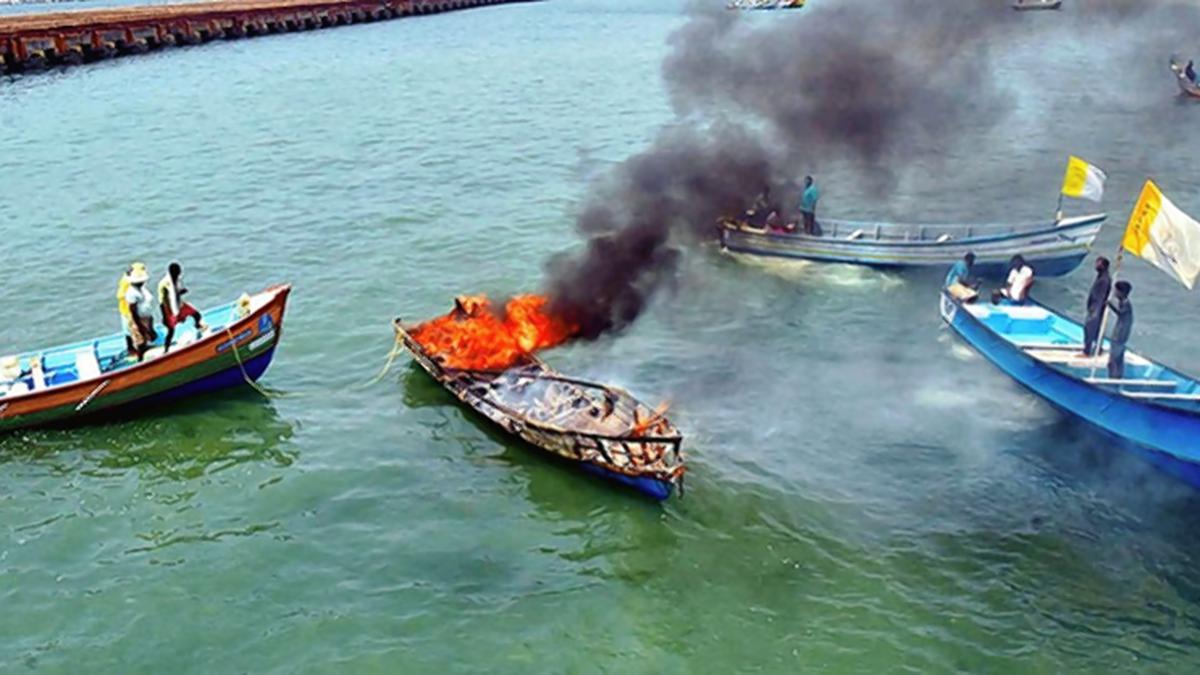
Explained | why are fisherfolk protesting the vizhinjam port project?
- Select a language for the TTS:
- UK English Female
- UK English Male
- US English Female
- US English Male
- Australian Female
- Australian Male
- Language selected: (auto detect) - EN
Play all audios:

THE STORY SO FAR: Vizhinjam has been on the boil for the past four months with protesters mainly fisherfolk and their families laying siege to the under-construction Vizhinjam port. The
protestors led by the Latin Archdiocese have been demanding the halting of the construction work of the port by Adani Vizhinjam Port Private Limited. WHAT LIES AT THE HEART OF THE PROTESTS?
According to protesters, the port work has aggravated the coastal erosion along the coast of Thiruvananthapuram. They have raised seven demands which include, a scientific study to assess
the impact of the port work on the shoreline after stopping the construction of the port. Further, around 300 families along the coastline were shifted to relief camps after their houses
were destroyed due to high-intensity coastal erosion. The protesters demand a comprehensive rehabilitation package for the fisherfolk in the region, an assured minimum wage when the sea
turns rough due to inclement weather, and subsidised kerosene for boats. ALSO READ: VIZHINJAM PORT | IN TROUBLED WATERS HAS IT AGGRAVATED COASTAL EROSION? All types of construction work
along a coast, aggravate sea erosion (loss of beach) and accretion (gain of beach). Any structure — be it groyne, seawall, or breakwater — intensifies erosion on one side and accretion on
the other. Although coastal erosion is dominant in all coastal districts of Kerala, it is more severe along the coastline of Thiruvananthapuram. A study conducted by the National Centre for
Sustainable Coastal Management, Society of Integrated Coastal Management, and the Ministry of Environment and Forest had noted that the erosion is minimum at Thrissur (1.5 %) and maximum at
Thiruvananthapuram (23%), even before the port construction. In Kerala’s case, the seasonal shoreline changes would be more severe during monsoon months due to the high-energy short storm
waves that lash the coast almost in a perpendicular position moving the sand offshore. The latest report of the expert committee appointed by the National Green Tribunal and Shoreline
Monitoring Cell observed that erosion in spots such as Valiyathura, Shanghumugham, and Punthura remained the same as before and after the commencement of the port construction (December
2015). However, during the October 2020–September 2021 period, spots like Kochuveli and Cheriyathura to the north of Valiyathura suffered erosion. The report noted that the relatively high
number of cyclones formed over the Arabian sea after cyclone Ockhi in 2017 was the main reason for the recent erosion and accretion and that the impact of the port activity on either side of
the coast had less significance. WHAT IS THE GOVERNMENT’S STANCE? The Kerala Government made it clear that since the coastal erosion is due to climate change as reported by various
agencies, the demand for stopping the port construction cannot be conceded. Officials argue that the Vizhinjam seaport is being constructed inside a natural sediment cell which is a
pocket-like area in which interruptions to the movement of sand along the coast do not significantly affect the adjacent coastline. ALSO READ: GOVERNMENT REJECTS FISHER’S DEMAND TO HALT
VIZHINJAM PORT CONSTRUCTION IS THE VIZHINJAM PROJECT IMPORTANT? Located on the southern tip of the Indian Peninsula, just 10 nautical miles from the major international sea route and
east-west shipping axis, and with a natural water depth of more than 20m within a nautical mile from the coast, the Vizhinjam port is likely to play a pivotal role in the maritime
development of the country and Kerala. The port is expected to leverage the growth of minor ports in Kerala and other regional ports, creating thousands of employment opportunities. *
According to protesters, the port work has aggravated the coastal erosion along the coast of Thiruvananthapuram. * All types of construction work along a coast, aggravate sea erosion (loss
of beach) and accretion (gain of beach). Any structure — be it groyne, seawall, or breakwater — intensifies erosion on one side and accretion on the other. * The Kerala Government made it
clear that since the coastal erosion is due to climate change as reported by various agencies, the demand for stopping the port construction cannot be conceded. Published - December 06, 2022
10:30 am IST Read Comments Remove SEE ALL PRINT RELATED TOPICS Text and Context / The Hindu Explains / sea level rise / environmental politics / Kerala
